The Taklamakan Desert Crossing Expedition

Our caravan on its way to making the first ever crossing of the 780 mile Taklamakan Desert in western China.
In 1993 I was the photographer for the Royal Geographical Society’s expedition that made the first crossing of the Taklamakan Desert in Western China. With 13 individuals, 34 camels, and a resupply team traveling in military transport vehicles, the team made the very first crossing of earth’s second largest sea of sand, the Taklamakan Desert (780 miles in diameter.) The expedition was comprised of two teams, the desert crossing team and the re-supply team. I would spend time traveling with each team and trade off at the resupply points, thus allowing me to document the expedition as a whole. In the end I logged 390 of the 780 miles with the crossing team. The re-supply team shadowed the crossing team’s progress a hundred miles to its south traveling along the ancient Silk Road. Every 100-200 miles the re-supply team would push north into the desert in 6 wheel drive military transport vehicles to supple the crossing team with fresh water and food. It was my job to photographically document the life of the expedition’s desert crossing team for the British and Chinese media, a book on the expedition (Amazon), and the countless sponsors of the expedition (ie. Motorola, British Airways, British Petroleum, Bauch and Lomb, Patagonia, the BBC, The London Times, and many many others.)
Although in China, this region is dominated by the Turkic ethnic group known as Uighurs. Uighurs share more ethnic and cultural similarities with Kyrgyzstan, Tajikistan, Kazakhstan and Mongolia ― China’s northern and western neighbors on the Eurasian Steppe ― than with the rest of China itself. The Uighurs were some of the most generous people I have ever met. Being quite different looking than them, when I was documenting the life of our resupply team it was hard not to attract a crowd around me wherever I walked. I was frequently invited into homes (mud or brick, single room, usually with a simple courtyard in front) to enjoy tea and fresh nan (bread) or a slice of watermelon. I fondly recall trying to communicate with them hand gestures. We shared lots of smiles and laughter.
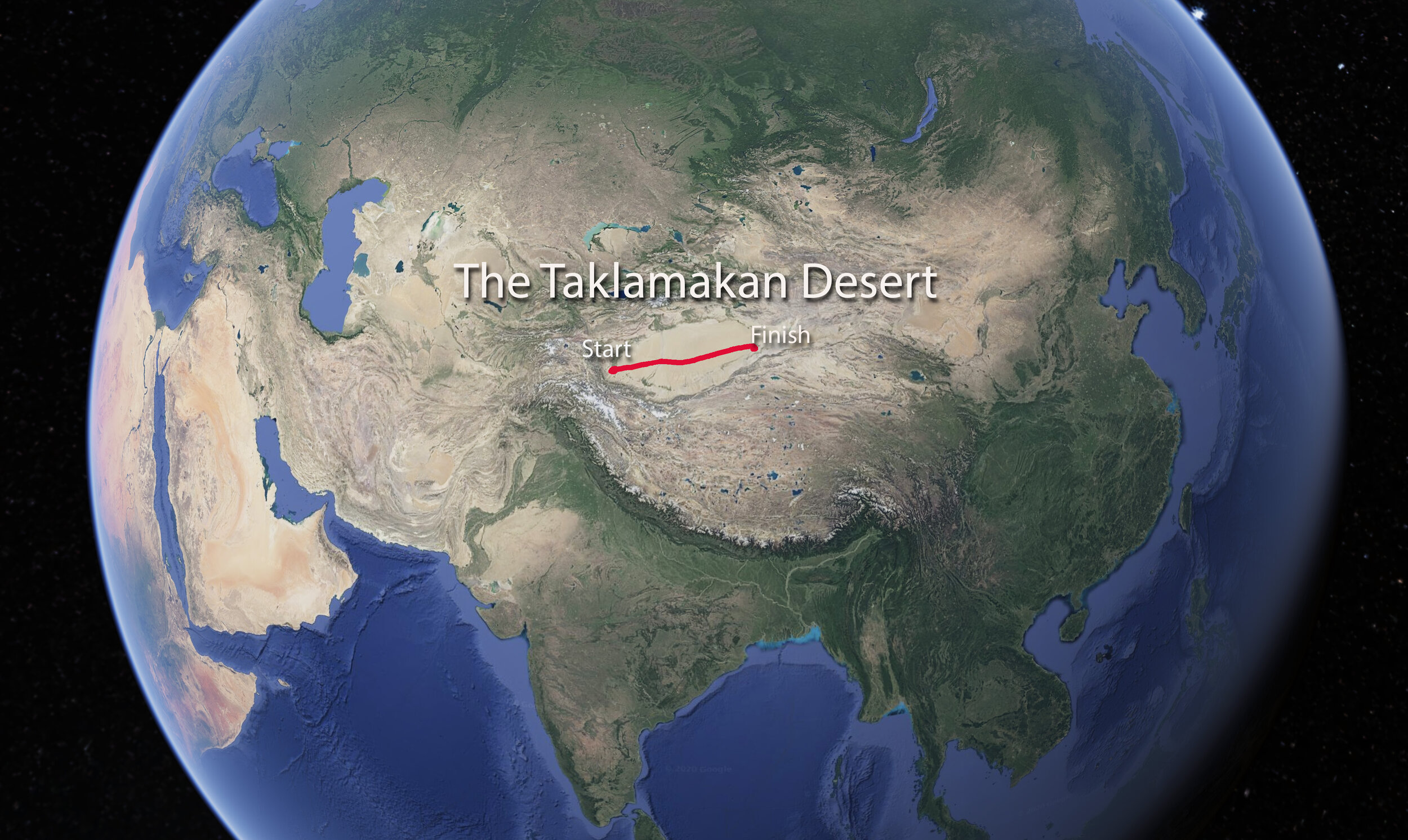
Visually the Taklamakan Desert is a very distinct geologic feature on the globe. It is known as the land farthest from the sea and its name translates to “You go in but you don’t come out.” The red line marks our 780 mile route.

Team members Rupert Burton and Carolyn Ellis break trail and choose the best route through the dunes for the camel team.

I frequently walked my own line through the dunes so that I could be far enough away from the team to photograph them in relationship to their surroundings.

Carolyn alone in the dunes.

The Western contingent of the crossing team (plus Guo Jing Wei). Yes, that is a much younger me on the right in blue. :)

It took the crossing team 59 days to cover all 780 miles of the desert.

Life in this region of the world has not changed much over the past century.

It was difficult to move the teams of camels together as a unit especially at moments like this when the terrain forced them to move ahead at different speeds. Frequently the rope between the camels would break and then there was mayhem! Especially if some gear started to come loose on their back. They would try to shake it free as they pranced off into the dunes.

The Taklamakan Desert is the second largest sea of sand in the world. Only the Sahara is larger.

Esa Polte, one of the Uighur camel handlers climbs a giant dune near camp at the end of a day.

The re-supply team was equipped with 6 wheel Austrian Pinzgauer transport vehicles. They would make forays into the desert every 100-200 miles to bring the crossing team more provisions.

As able as the Pinzgauer transports were they were still vulnerable to getting stuck.

The re-supply team was stuck for nearly 4 days in this incident along the Keriya River.

The re-supply team’s unintended camp.

Another incident that the re-supply team got into was when one of the Pinzgauers became lodged in a jumble of logs that it was trying to cross a river on.

Trying to free the logs from under the vehicle was not only physically dangerous but if we took out the wrong one the vehicle could easily fall on its side in the water.

When the crossing team and the re-supply team met in the desert there was always great stories to be shared and logistics to be worked out.

Paul Treasure cooking up a storm on his desert mud stove.

Two of our re-supplies were at tiny remote villages deep in the desert along ancient river beds. Here the crossing team members enjoy a rare beer brought to them by the re-supply team.

The crossing began at an elevation of 5000 feet on Sept. 24 and finished at an elevation of 4000 feet on Nov. 21. Needless to say the temperatures dropped well below freezing the final weeks of the crossing.
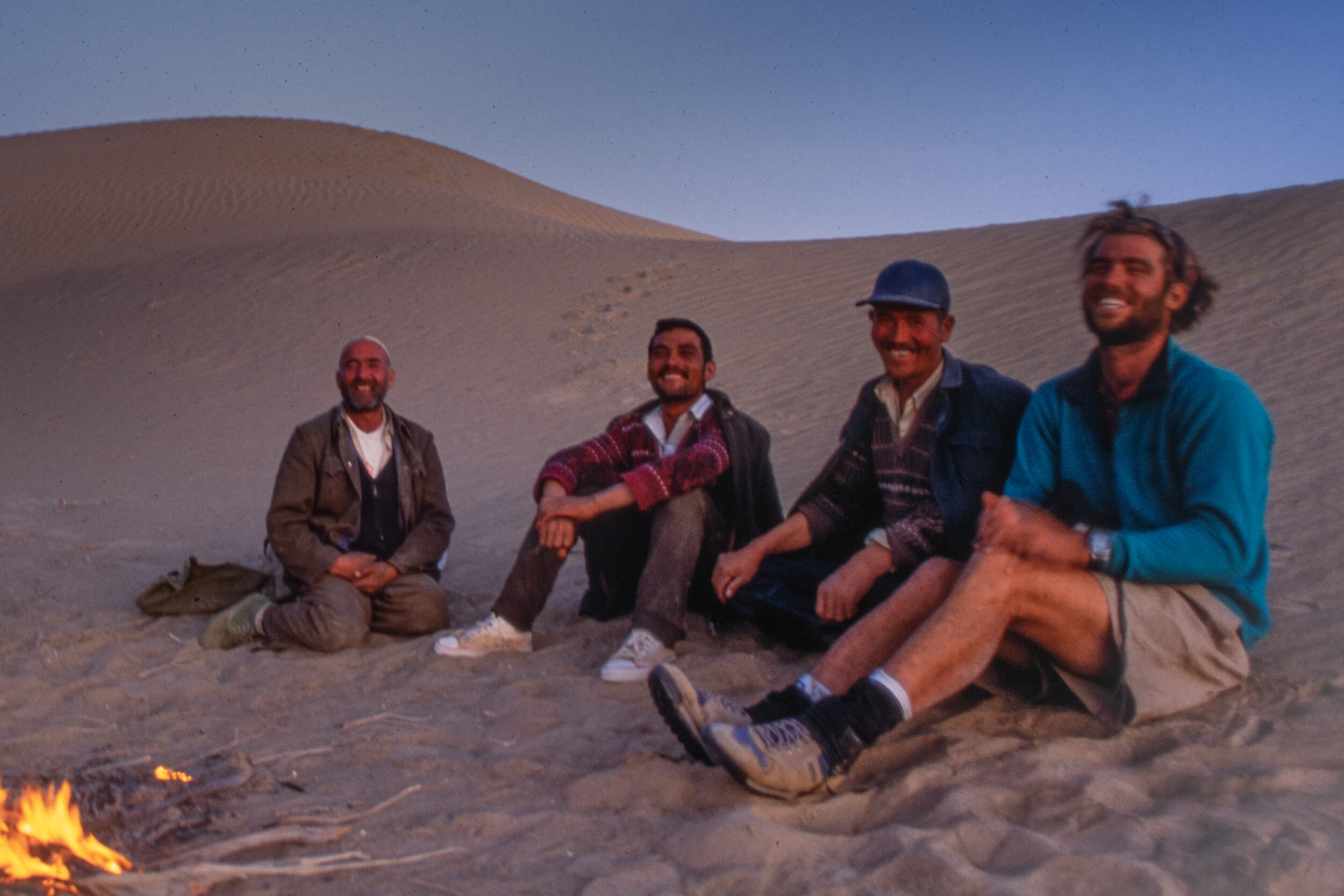
A rare photo of me. Enjoying the evening campfire with some of my local friends.

The day before the start of the crossing the locals held a huge parade and send off event for the team.

Rupert sits atop our supplies at the airport in Beijing.

We had different ranks for the camels. The stronger and more mild tempered ones were used to carry out personal water supply. While the younger more temperamental ones carried sleeping bags and our clothing as they could do little damage to these items.

Mark and Rupert prep the satellite phone for media calls.

Mark and Rupert place the antenna for communication with the re-supply team a hundred miles to our South.

Most evenings the crossing team had to dig an enormous pit to find water for the camels to drink. Sometimes retrieving water from it could be dangerous.

The sand quality changed throughout the desert. In some areas you barely left a footprint and in other areas you could sink down to your calf.

In the morning the caravan would start off together but as the day wore on groupings of around 7 camels and several team members would start spreading out over the route chosen by the days navigator.

Major Charles Blackmoore, our fearless leader, in the dunes.

Dwarfed by the sculpted sand.

Charles leads the way toward the distant Marzatagh mountain range. This shot graced the cover of the hardback book on the expedition.

As we approached the Marzataug Mountain range in the middle of the Taklamakan the dunes became smaller and more erratic.

Lunch was a simple affair. We carried it it our daypacks and sat down for around 30 minutes to rest and replenish.

The Marzataug Mountains and an ancient Buddhist temple.

Mark Kitto rides off into the sunset.

Richard writing in his journal. I’ve never been consistent with journaling but I was on the expedition and I am so grateful that I was. It is fascinating to read back on my experiences and thoughts.

Daybreak. We all had duties in the morning assigned to make the team as efficient as possible and to get on our way as quickly as possible.

The arduous task of loading camels. It took approximately 2 hours every morning to break camp and get the camels loaded up.

The dry air and desert sun took its toll on us.

Rupert enjoys lunch with his friend Chumba.

Another camp, another well to dig for water.

Rupert steadies a camel as Carolyn our team nurse and honorary vet, took the scalpel to an infected wound on a camel.

There was ample time to contemplate things.

This lone poplar tree was a site for sore eyes.

At times like this when I was off on my own trying to get interesting shots of the crossing team it was extraordinarily special. It was almost what I imagine being on a space walk would be like. So quiet, desolate, and yet there was still a little anxiety because you did not want to get separated from the team.

Storm clouds over the crossing team. While there was no rainfall during our crossing there were sandstorms, otherwise known as Kara Burans.

As a photographer there was a never ending supply of artistic and untouched sand dunes to photograph.

Camel detail.

Two of the Uighur camel handlers were named Abdul. As a sponsor to the expedition British Petroleum gave us a bunch of their hats. Guess what our nick name for this sweet man was? BP!

Rupert and Charles model their tattered Patagonia retro pile jackets for me. Actually this photo was from when I had been with the resupply team and we went out to meet the crossing team near the end of the expedition. I hiked out a mile or two to the West to greet them and this is the moment they walked up to me after not seeing any non-crossing team members for the previous 10 days.
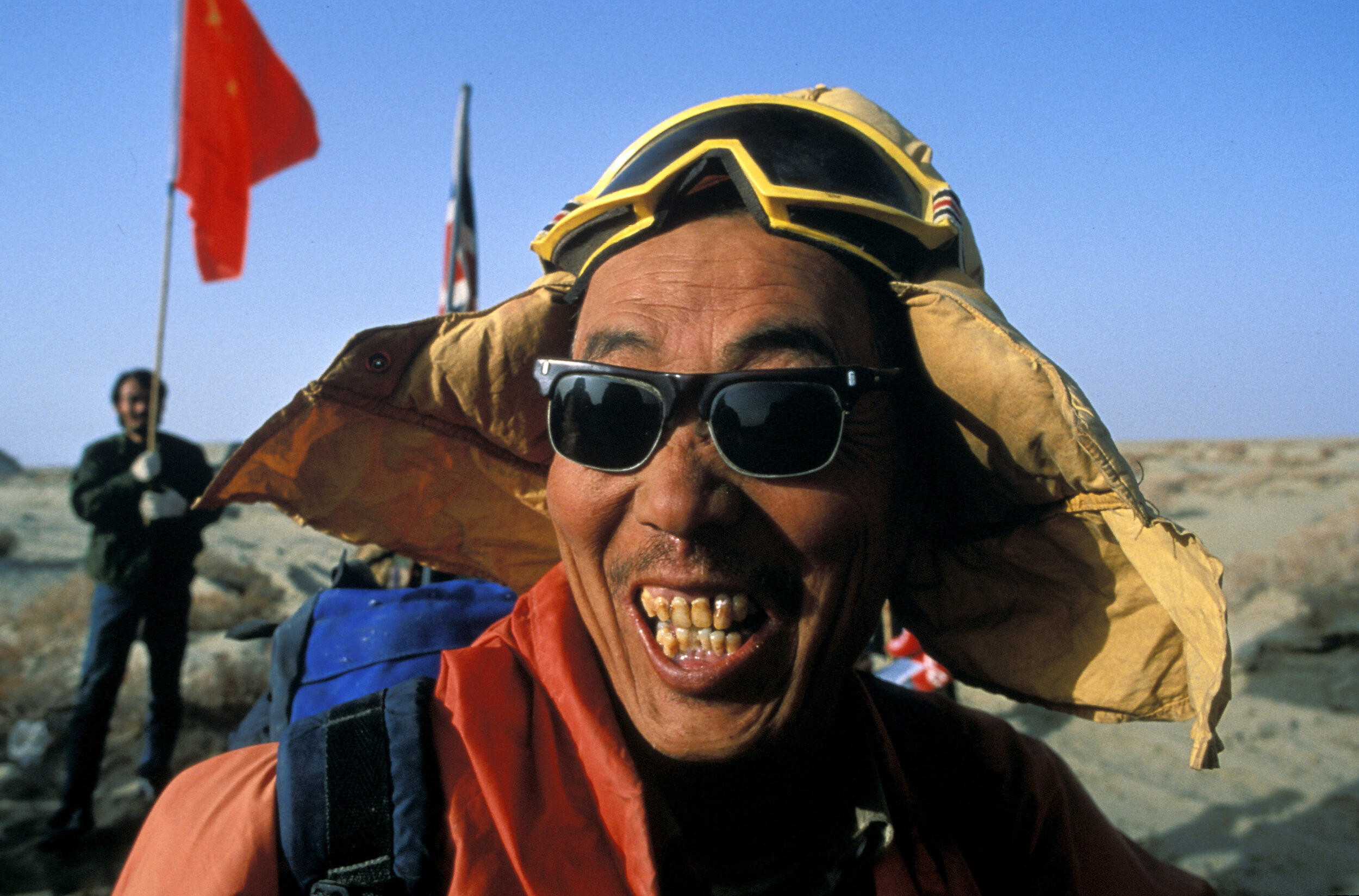
The mad scientist! Or so we called the man that the Chinese government sent to join us on the crossing. He actually was a scientist and he joined us to evaluate and study the Taklamakan for its potential oil reserves.

Charles keeping track of the provisions before embarking on another leg of our journey.

Both the crossing team and the re-supply team hamming it up for a photo for Ray Ban (one of our sponsors).

Back to business with the sand dunes.

As I have been going through these photos and making captions for them I can’t help but think, I was 25 years old when I was assigned the job of documenting this expedition. I can only dream of how these photos would have turned out if I shot them now, with over 30 years of experience in photography and probably still being fit enough to actually get across this desert. Back to the normal captions…..

Mark puts on a show for some of the Uighur children at an outpost deep in the desert.

The desert was simply enormous. We arrived at points like this every several days of travel only to see endless desert as far as the eye can see.

Charles being interviewed by Chinese Central Television.

The locals observe Carolyn taking inventory on our supplies.

The core members of the crossing team, Charles, Carolyn, Mark and Rupert.

The core members of the re-supply team and their vehicles.

The entire Western contingent of the team enjoying a meal together.

Carolyn cleaning and infected saddle sore on a camel.

Carolyn sharing her lunch with Chumba the camel.

Rupert trying to sort out matters of efficiency with the morning loading of the camels.

Rupert covered in smelly camel regurgitation. This is what the camels would do to you if they disagreed with you.

Rab gear was a sponsor of the expedition and here Rupert and Carolyn get good use of their Rab jackets while getting the cooker going in the predawn cold.

After a month in the desert the camel train was running pretty efficiently.

Carolyn sorting supplies. When the crossing team was with the re-supply team there was ample water so we would wash our smelly clothing (you can see it air drying in the background).

Along the Southern Silk Road a shepherd tends his flock. The Kun Lun Mountains are in the distance with Tibet on the other side of them.

Where cultures collide. It was always heart warming to meet locals on the re-supply team that have never seen a Westerner and yet you could share a smile, laugh, and a photo with them.

Charles navigates a path through a tricky section of dunes.

Carolyn enjoys one of the simple pleasures in life, a hard earned quiet moment enjoying a hot cup of tea.

After 59 days the crossing team arrives at the eastern edge of the desert. Both the Union Jack and the Chinese flags are carried the final steps of the crossing before we met with the press.

Charles and Gwo celebrate the completion of the first ever crossing of the Taklamakan Desert.
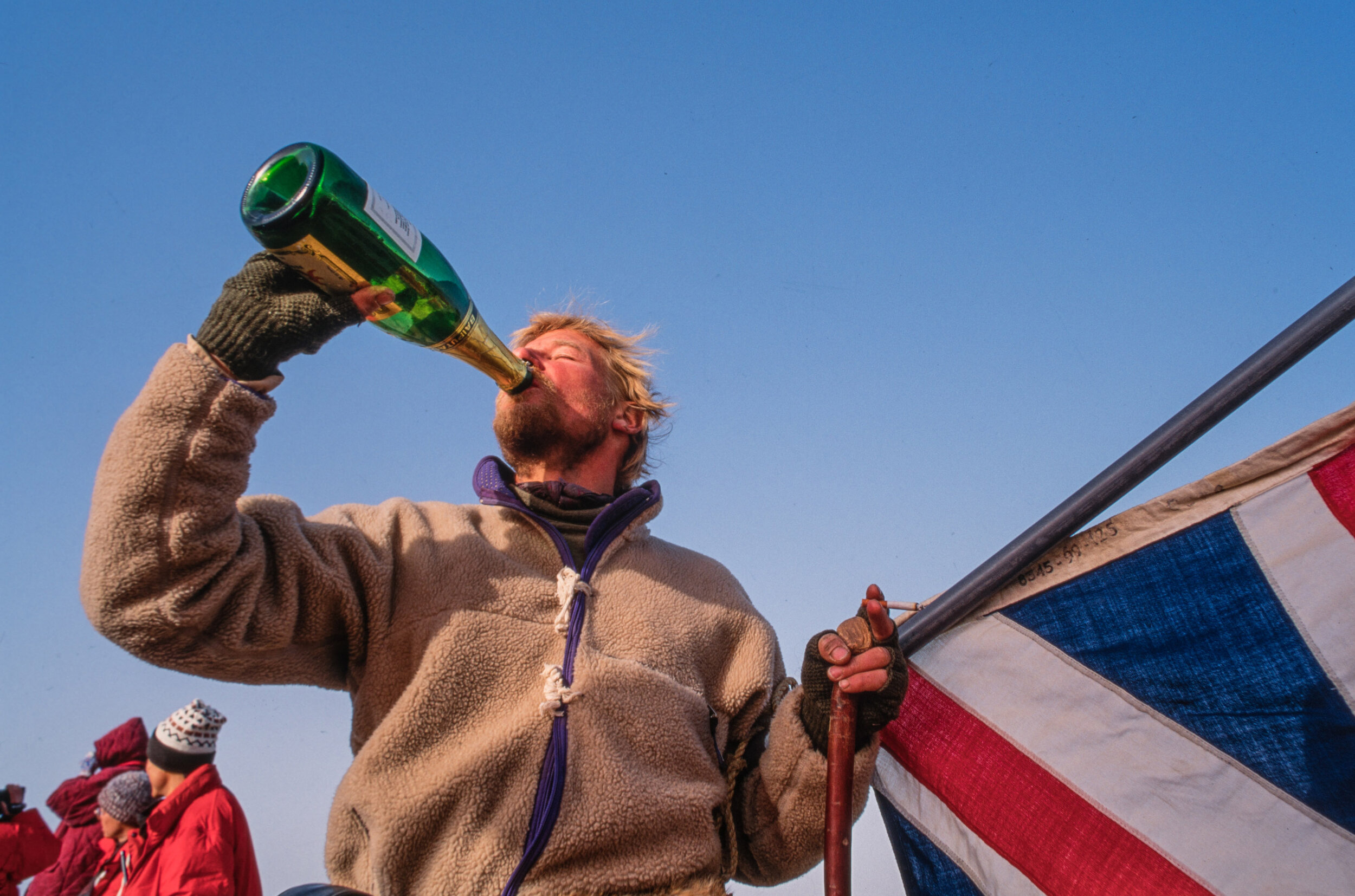
Charles celebrates.

Carolyn greets the locals while being paraded down the main street in celebration of the crossing.

The community threw a huge celebration marking the completion of the first crossing of the Taklamakan.

Carolyn is mobbed by the local children. She became quite the celebrity from the expedition. Not only was she the only woman in the crossing team, she was one of only two people (her and Rupert) who walked across the entire desert without riding on a camel. She was named explorer of the year in England and gave countless tv, radio, and newspaper interviews.

The entire crossing team being celebrated by the community.

The morning after completing the crossing and after a huge community celebration, the British members of the crossing team spend their last visit with the camels before beginning the long journey home.

For the last photos in this blog I want to feature the locals from this region of the world. They are ethnically Uighurs who are Turkish descendants. Currently there is a struggle going on as the Chinese government is forcing them into internment camps where they are said to be being “re-educated”. Re-educated means they are separating families and trying to indoctrinate them into becoming nationalistic and to loose their cultural and religious heritage.

The Uighur’s I met across the entire Tarim Basin were incredibly kind and generous. They invited me into their homes and shared food and smiles freely. Their lifestyle has changed very little in over a century.

The Uighurs I met were incredibly hard working, whether they were the members of our team or those working in the fields around the villages.

I stood out like a sore thumb when I walked through a village. I was a 6’2” blonde Californian and this region had been closed to westerners for many decades. Needless to say it was difficult to not attract a crowd when I walked around.

A glimpse of life in a Uighur village.

A captive hawk used for hunting in the desert.

The spice man at the local bazaar. I literally purchased a one gallon plastic bag of saffron for a few dollars and brought it back to California with me.

Portrait of a Uighur man.

A Uighur man just after his morning prayers.

Portrait of a Uighur Imam.

Silhouette of my friend Suleiman around an evening campfire.

The local Uighur butcher.

The Southern Silk Road lined with poplar trees as it enters the town of Ruojiang.
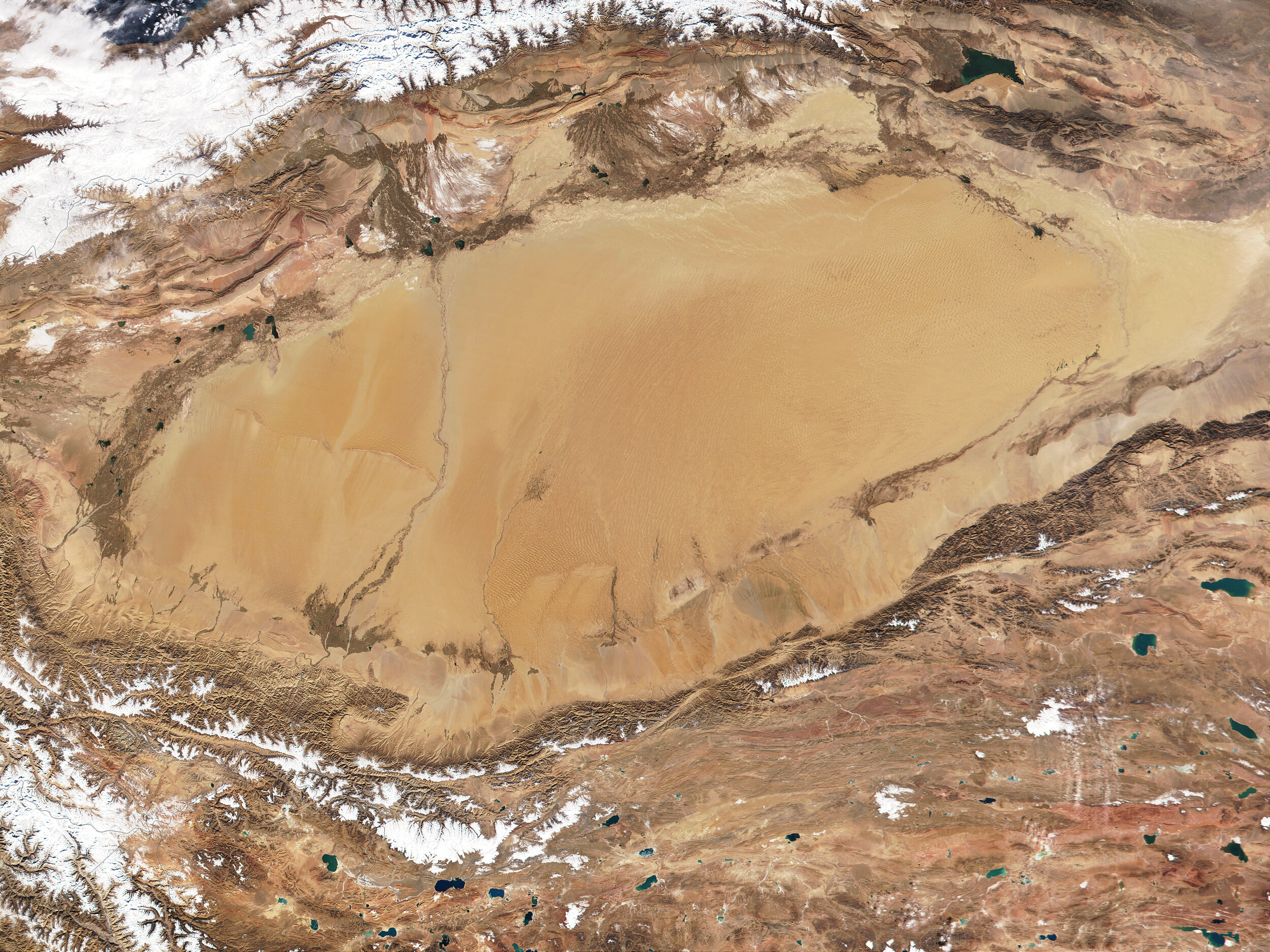
A more detailed look at the Taklamakan Desert. We started our trip at the left edge of the desert and completed it on the extreme right of this image. You can see a couple of the seasonal rivers that come into the desert from the South that were used by the vehicles to make re-supply runs to the crossing team.